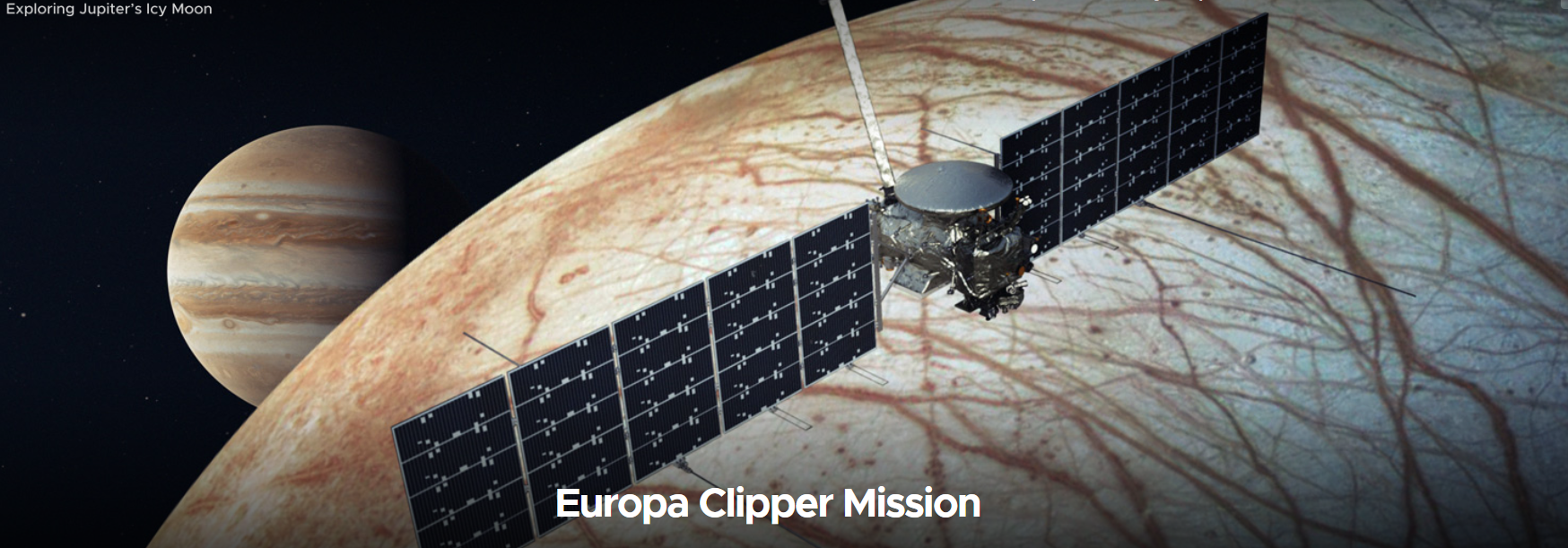7:15 AM | *Mission to Jupiter’s icy moon, Europa, begins a year from now in October 2024…amazing work by Galileo 400+ years ago…send your name on the spacecraft*
Paul Dorian
Overview
Galileo turned his primitive telescope towards Jupiter in the early 1600’s and saw tiny specks of light with no discernable features. What a difference 400+ years can make as today’s backyard telescopes can resolve Europa’s disk surprisingly well. Europa is now considered one of the most complex and fascinating worlds in the solar system. Cracks, ridges, and chaotic terrain on the moon's icy crust may offer access to one of the largest oceans in the solar system--and a possible abode for aquatic life. NASA's Europa Clipper spacecraft, due to launch one year from now in October 2024, will conduct a detailed reconnaissance of the moon's surface to help plan future missions including a lander and perhaps even a submarine.
Discussion on Europa and the mission
Europa is a world that shows strong evidence for an ocean of liquid water beneath its icy crust which could very well host conditions favorable for life. NASA will place a highly capable, radiation-tolerant spacecraft named “Clipper” into a long, looping orbit around Jupiter to perform repeated flybys of the icy moon. In fact, the plan is to have nearly 50 flybys of Europa at closest approach altitudes as low as 16 miles, soaring over a different location during each to scan nearly the entire moon. With its massive solar arrays and radar antennas, Europa Clipper will be the largest spacecraft NASA has ever developed for a planetary mission. The spacecraft needs large solar arrays to collect enough light for its power needs as it operates in the Jupiter system, which is more than five times as far from the Sun as Earth. The spacecraft will be about 16 feet (5 meters) in height. With its arrays deployed, the spacecraft spans more than 100 feet and has a dry mass (no propellant in the tanks) of 7,145 pounds. The launch date for this spacecraft is currently set for about one year from now in October 2024 with arrival at Jupiter in April 2030.
Credit: NASA/JPL-Caltech
Because Europa is bathed in radiation trapped in Jupiter's magnetic field, Europa Clipper's payload and other electronics will be enclosed in a thick-walled vault. This strategy of armoring up to go to Jupiter with a radiation vault was developed and successfully used for the first time by NASA’s Juno spacecraft. The vault walls – made of titanium and aluminum – will act as a radiation shield against most of the high-energy atomic particles, dramatically slowing down degradation of the spacecraft's electronics.
For Europa to be habitable, it needs the essential building blocks for life including carbon, hydrogen, oxygen, and sulfur. Liquid water is essential for the complex chemistry that makes life on Earth possible. Many scientists predict a salty ocean lies beneath the surface of Europa which has more water than all of Earth’s oceans combined. While the icy moon of Jupiter is far from the sun, Europa gets the energy to sustain life from Jupiter’s strong gravity which creates tides that stretch and tug the moon producing heat. One of the most important measurements by the Galileo mission which previously explored Europa showed how Jupiter’s magnetic field was disrupted in the space around Europa. The measurement strongly implied that a special type of magnetic field is created (induced) within Europa by a deep layer of some electrically conductive fluid (like saltwater) beneath the surface, which interacts with Jupiter’s strong magnetic field.
The amazing work of Galileo
Peering through his newly-improved 20-power homemade telescope at the planet Jupiter on Jan. 7, 1610, Italian astronomer Galileo Galilei noticed three other points of light near the planet, at first believing them to be distant stars. Observing them over several nights, he noted that they appeared to move in the wrong direction with regard to the background stars and they remained in Jupiter’s proximity but changed their positions relative to one another. He later observed a fourth star near the planet with the same unusual behavior. By Jan. 15, Galileo correctly concluded that they were not stars at all but moons orbiting around Jupiter, providing strong evidence for the Copernican theory that most celestial objects did not revolve around the Earth. In March 1610, Galileo published his discoveries of Jupiter’s satellites and other celestial observations in a book titled Siderius Nuncius (The Starry Messenger).
Top: Two of Galileo’s telescopes. Bottom: Page from Galileo’s notebook about his observations of Jupiter’s satellites. Credits: National Geographic, gabrielevanin.it, University of Michigan Special Collections Library.
As their discoverer, Galileo had naming rights to Jupiter’s satellites. He proposed to name them after his patrons the Medicis and astronomers called them the Medicean Stars through much of the seventeenth century, although in his own notes Galileo referred to them by the Roman numerals I, II, III, and IV, in order of their distance from Jupiter. Astronomers still refer to the four moons as the Galilean satellites in honor of their discoverer. The German astronomer Johannes Kepler suggested naming the satellites after mythological figures associated with Jupiter, namely Io, Europa, Ganymede, and Callisto, but his idea didn’t catch on for more than 200 years. Scientists didn’t discover any more satellites around Jupiter until American astronomer E.E. Barnard found Jupiter’s fifth moon Amalthea in 1892, much smaller than the Galilean moons and orbiting closer to the planet than Io. It was the last satellite in the solar system found by visual observation – all subsequent discoveries occurred via photography or digital imaging. As of today, astronomers have identified 79 satellites orbiting Jupiter.
Send your name to Jupiter
One final note, NASA has set up a web site to have your name engraved on the spacecraft as it travels the 1.8 billion miles to explore Europa. For more detailed information on Europa, visit this NASA web site.
Meteorologist Paul Dorian
Arcfield
arcfieldweather.com




